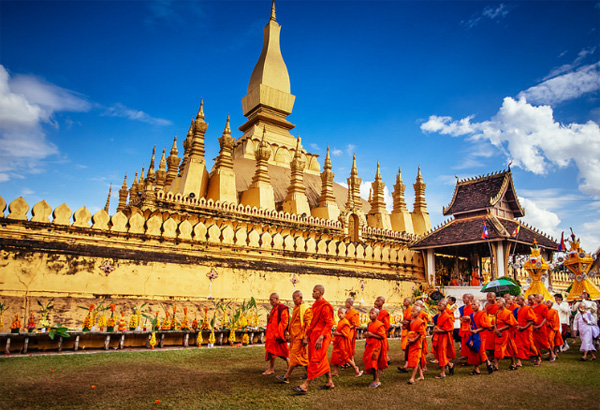For such a small place, Laos is surprisingly hard to pin down. You come away feeling the ever-present Mekong, the country's economic and spiritual lifeline, is the one thing you can be sure of.
South East Asia's longest river winds its sinuous but insistent way from top to bottom of this long, thin, landlocked country also known as the "Land of a million Elephants".

Rising, like all the great rivers of Asia, on the Tibetan plateau, the Mekong makes its way through six countries before emptying into the South China Sea, more than 4,000km (2,500 miles) from its source.
But it is Laos more than any other single nation that seems to belong to the Mekong.
It grew up along the river's banks. The Mekong united the country's many ethnic groups. It remains the major focus of settlement and the national highway of trade.
'Mother of rivers'
The word Mekong translates in Lao as "Mother of Rivers". As one Lao told me: "Its water is our blood."
Its flood plains provide rice, its waters fish (the people's main source of protein) and its 2,000km (1,250-mile) passage through Laos is still the most convenient communication route.

The French colonised Laos mainly because they hoped the Mekong would link them to the fabled riches of China.
The upper reaches of the river proved unnavigable. But China itself is busy deepening and widening the river to improve trade and tourism links with South East Asia. Small islands have been blasted away in their entirety.

The Chinese are also building dams, siphoning off water needed by countries further downstream, like Laos and Cambodia.
Potential for conflict
This is just one of a host of potential sources of conflict between the six countries sharing the Mekong.
Other concerns include the over-harvesting of fish, pesticide run-off and the dumping of human waste. Massive deforestation has already caused annual flooding.
To manage the resources of the river basin and harness the waters for hydropower and irrigation, the Mekong River Commission was set up in 1995 by Laos, Thailand, Cambodia and Vietnam, with China and Burma as dialogue partners.
The director of the Laos Mekong River Committee, Boriboun Sanakisam, took me out in one of the high-speed powerboats favoured by rich, young Thai businessmen keen to do business with their resource-rich neighbour just across the river.
He assured me that the commission provided a forum in which the various neighbours could iron out their problems smoothly, with what Asians like to call their traditional aptitude for consensus.

But ever since its 14th century heyday, Laos has found itself the helpless victim of its bigger neighbours as it struggled to play them off against each other.
As a waiter at my hotel told me, Laos is like a small boat that can easily be upset when larger craft come too close.
Changing pace
In the north of the country, I took a small longtail boat down the Mekong and retraced the journey taken by countless Lao kings from the Buddha caves of Tham Ting to the royal jetty at the old capital of Luang Prabang.
The thick, treacly, almost purple-coloured water oozed past and all I could hear were the birds in the forest on either bank. Golden-roofed temples peeked up through the trees.

Four-hundred kilometres (250 miles) downstream, the present capital of Vientiane is beginning to buzz with nightclubs and modern hotels.
But even here, the pace of life is still far slower than in any other Asian capital.
One senses that what Laos really wants is to remain as undisturbed as possible, tucked away behind its mountains and its river.
For the time being, at least, the mood is still: Who cares? As long as we've got the Mekong, life goes on.
This article was first published on BBC.com on Aug 21, 2001, written by Tim Luard




















